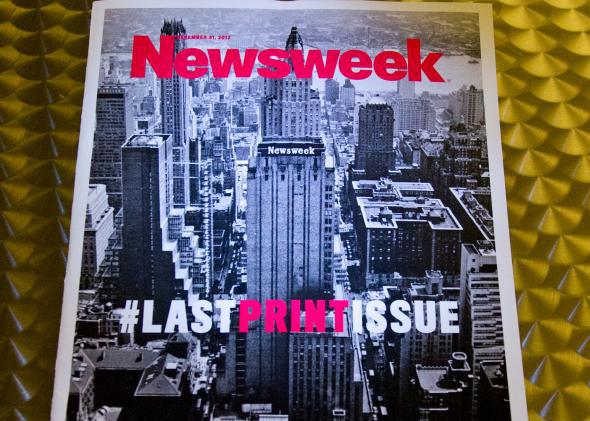Newsweek, the once mighty weekly that ceased printing last year in favor of producing an online-only magazine, is getting back in the paper and ink game—a decision clearly at odds with recent trends in the magazine industry. The New York Times:
The magazine expects to begin a 64-page weekly edition in January or February, said Jim Impoco, Newsweek’s editor in chief. Mr. Impoco said in an interview that Newsweek would depend more heavily on subscribers than advertisers to pay its bills — and that readers would pay more than in the past. “It’s going to be a more subscription-based model, closer to what The Economist is compared to what Time magazine is,” Mr. Impoco said. “We see it as a premium product, a boutique product.”
At its early-90s peak, Newsweek boasted a circulation of more than 3 million readers at a time when print ads largely subsidized subscription prices. Now that the company is hoping to rely almost exclusively on subscriber revenues to foot the bill—“We won’t charge less than it costs to produce,” Impoco said—the magazine has set a rather modest-sounding first-year circulation goal of 100,000. That figure, however, is a far cry from the total circulation of the magazine Impoco name-dropped as his exemplar: The Economist boasts a global print circulation of nearly 1.5 million, a little more than half of which comes from the United States. It’s not yet known what Newsweek will charge for an annual subscription, but, for what it’s worth, one-year of The Economist will run you a pricey $160.
The announcement leaves Newsweek largely swimming against the current in an industry where many legacy publications have come to the painfully slow realization that their financial future most likely exists online. Still, the magazine is not alone in its refusal to shrink its print presence in favor of its digital one. The Week, which also relies on the subscriber-over-ad-revenue model, also announced yesterday that it was expanding its publishing frequency from 48 times a year to 51.
***Follow @JoshVoorhees and the rest of the @slatest team on Twitter.***
